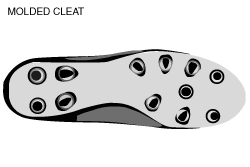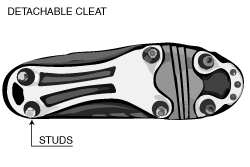Soccer Cleats
Construction and materials make big differences in soccer cleats. Our guide explains what to look for in yours.
How To Buy Soccer Cleats
Soccer is a game that is primarily played with your feet; therefore, your most important piece of soccer equipment is your footwear. A good pair of cleats, or boots as many people call them, is essential. There are variations of the basic soccer cleat designed for different skill levels, weather conditions, and field types.
Types of Cleats
Footwear for soccer depends on a number of factors: the level of your game, the types of fields you play on, and how much you want to spend. Most leagues require you wear the proper type of soccer cleat during play, so it is most important to understand which type you need.

Molded cleats
- Basic soccer shoe design
- Non-removable rubber, or hard plastic formed on the bottom of the shoe is used to help provide traction and control
- Ideal for beginning and intermediate level players
- Suited for play on almost all field types and in all weather conditions
- Required by many youth programs for safety reasons

Detachable cleats
- Feature studs on the bottom that can be screwed on and off and be replaced easily
- Cleats vary in length and are usually made of hard plastic or plastic with metal tips
- The type and length of the studs can be changed depending on the weather and field conditions of that day's game or practice
- Ideal for experienced players who can tailor the cleats to their playing field and weather conditions
- Suitable for use on wet, soggy fields, or on well-groomed, soft grass fields
Turf shoes
- Contain various raised patterns on the bottom in place of studs, for use on harder outdoor surfaces and on artificial turf
- Generally good training shoes that could serve as a back-up game pair for hard-surface conditions
Indoor shoes
- Resemble low-cut, lightweight sneakers
- Designed for playing indoor soccer in a gym or recreational facility
- Feature a flat, rubbery-type bottom for better traction on indoor courts and fields
- Required by many indoor soccer facilities when playing on artificial turf, so the turf does not get torn up
Sandals
- An important footwear add-on for all soccer players
- Worn before the game to save wear on your soccer shoes
- Easy to slip on and off when soccer socks and shin guards are on
- Allow you to immediately remove your playing shoes after a game to rest your feet
- Many sandals have special massage-type features for the bottom of the foot for added comfort
Materials
Soccer shoes come in two basic materials: leather and synthetic. The pair you purchase will largely depend on your skill level and how serious you are about the sport.
Leather
- Offer the best feel and fit of any soccer shoe, but are also generally more expensive
- Full-grain leather shoes are strong and durable, while variations such as Kangaroo leather are more flexible and offer an even better feel
- The softer the leather, the better the feel for the ball, but also the less durable the shoe
- Absorb more water than synthetic shoes and are not recommended for constant use on wet fields; however, water treatment options are available
Synthetic
- Ideal for most entry and mid-level players
- Generally less expensive than leather shoes, but do not offer as good a feel and do not last as long as a well-cared for leather boot
- Generally contain some sort of water treatment and therefore last better under poor playing conditions
- Easier to clean and dry out than leather shoes
Determining Your Size
Fit tips
- Soccer shoes are sized like regular shoes, but most are designed with a narrower upper than typical sneakers to allow for better feel and control of the ball.
- High-quality leather shoes will generally stretch a bit when worn. They will actually mold to the shape of your foot, so they should fit snugly when new.
- Shoes that are too small are one of the major causes of foot pain and problems with athletic footwear; however, soccer cleats should naturally fit more snugly than other athletic shoes because of their design.
Determining your shoe size
- Determining your proper shoe size is essential to a comfortable fit
- Don't assume your shoe size is the same as it has always been. The shape of you feet changes over time.